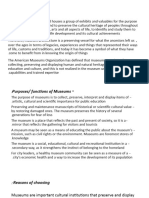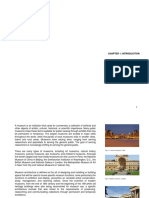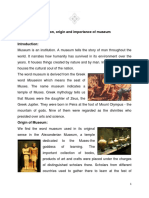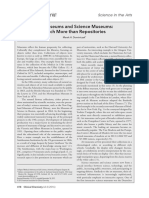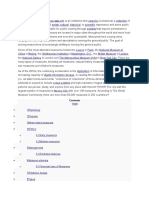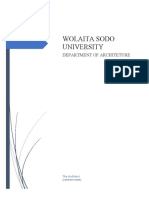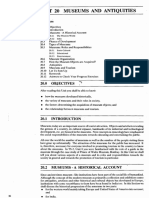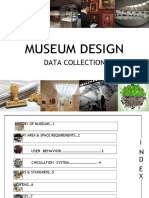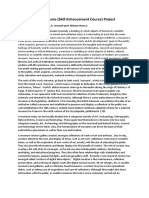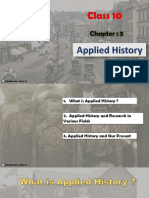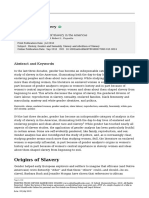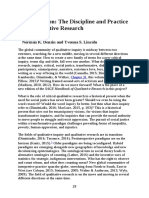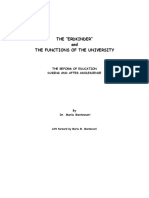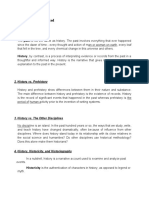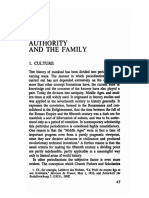International Research Journal of Engineering and Technology (IRJET) e-ISSN: 2395-0056
Volume: 11 Issue: 05 | May 2024 www.irjet.net p-ISSN: 2395-0072
NATURAL HISTORY MUSEUM
K. SUNITHA RANI1, T. SWAPNA2, T. JHANSI3
1 Assistant Professor, Dept of Architecture and Planning, University College of Architecture and Planning, A.N.U,
Guntur, AP.
2 Assistant Professor, Dept of Architecture and Planning, University College of Architecture and Planning, A.N.U,
Guntur, AP.
3 Assistant Professor, Dept of Architecture and Planning, University College of Architecture and Planning, A.N.U,
Guntur, AP.
---------------------------------------------------------------------***---------------------------------------------------------------------
Abstract The art of spaces is called architecture. Sometimes 1.1 PURPOSE
architectural space had an impact on human emotions. These
are places where individuals may go to engage in culture. Before you begin to format your paper, first write and Just
Study and appreciate art. A few museums are well-known for like education, public natural history museums provide
their art collections. The effect of architectural space across entertainment while also serving as a means of education. A
time is the main topic of this essay. The way spares are natural history museum's main purpose is to supply the
arranged in relation to exhibits to provide a certain impact is scientific community with both historical and contemporary
a theoretical and practical challenge in museum and gallery specimens for their studies, which advances our knowledge
design. Communicate the intended message to the guests. All of of the natural world. It offers a wealth of research
the functional and spatial specifications needed for museum opportunities for scientists and research institutions, which is
development are included in this project. Through advantageous to them, as well as conversational
architectural manifestations, it hopes to impress visitors with opportunities for the species.
a vivid history of its evolution. Cultural architecture,
particularly museum architecture, has a big social impact and 2. HISTORY AND EVOLUTION OF MUSEUMS
improves people's quality of life. Therefore, it is important to
examine this type of architecture from a variety of angles in 2.1 HISTORY OF MUSEUMS
order to fully understand its spatial composition and
functional organization. Early museums were originally private collections of
uncommon or unusual natural relics and objects
Keywords: Natural history museums, Non-formal owned by affluent people, families, or institutes of
education, Learning experience, Indian visitors, art.
Environmental awareness, Nature conservation,
Heterogeneous society, Contextual model of learning The "respectable" could frequently get entry to these
museums for the general public, particularly to
1.INTRODUCTION private art collections, although this was subject to
the owner and his employees' whims.
Anybody may attend a museum, regardless of qualifications,
and find inspiration in the tales of our past and present. The
museum is the path ahead for human development. An
Purchasing and showcasing these intriguing
artifacts was one method that wealthy men at this
organization that looks after, or conserves, a collection of
time rose in the social hierarchy of the elite world.
artifacts and other items with artistic, cultural, historical, or
scientific value is called a museum. These objects are on From ‘mouseion’ to museum
display for the public to see in a number of public museums
through either temporary or permanent displays. A museum The Greek mouseion, which denotes a location or temple
is a facility that chronicles human history. One of the main devoted to the muses, is the source of the Latin term
goals of museums is to teach, and education is one of the most museum, plural musea, from whence the word "museums" is
crucial development requirements." derived. A museum is a shrine, where the values of
knowledge and art are paramount. It strikes a balance
Three primary tasks of a museum: between artistic dedications.
• Education
• Presentation
• Forming of a collection.
© 2024, IRJET | Impact Factor value: 8.226 | ISO 9001:2008 Certified Journal | Page 1218
� International Research Journal of Engineering and Technology (IRJET) e-ISSN: 2395-0056
Volume: 11 Issue: 05 | May 2024 www.irjet.net p-ISSN: 2395-0072
2.2 Types of museums as gauche, although several galleries in major cities like
Tokyo charge artists a daily flat fee.
2.2.1 Early museums
Early museums were originally private collections of
uncommon or unusual natural relics and things owned by
affluent people, families, or institutions. These were
frequently on show in what were referred to as wonder
chambers or cabinets of curiosities. Respectable people could
frequently gain public admission, especially to private art
collections, but this was subject to the owner's and his
employees' whims. Ennigaldi-Nanna's museum, which was
established in around 530 BC and featured Mesopotamian
artifacts, was the oldest museum of its kind that has been
found. It seems to have had enough visitors to justify labeling
the organized collection, but there is no proof of this. Fig -3: Contemporary art gallery
2.3 Ancient History Museum (B.C.):
The concept of creating or expressing a museum dates back
to ancient BC. An essential component of the historical
libraries and schools was the museum. At his desire, a large
library filled with priceless treasures and antiques was
constructed in the Tal El Amarna area during the reign of
Pharaoh Akhenaten (1335–1353 B.C.). Some cloned
fragments of ancient, valuable pieces made of the same
materials were discovered in Larsa, Mesopotamia (modern-
day Iraq), dating back to the second millennium B.C. These
fragments have been used for educational purposes. Sir
Fig -1: Early Museums Leonard Woolley also discovered other parts of Babylonian
city, which demonstrate how the monarchs Nebuchadnezzar
2.2.2 Modern museums and Nabonidus cared for collections during their reigns.
However, the middle and upper classes were frequently the
only ones with access to these "public" museums. It can be
challenging to get in.
Fig -4: Terracotta warriors and horses
2.4 Museums of Medieval from the 5th to the 15th
century:
The introduction of Christianity in medieval Europe
Fig -2: Modern Museums highlighted new developments in the religious philosophy
and culture of the period, giving the church a high priority
2.2.3 Contemporary art gallery among rulers such as princes and dip-lomats. The majority of
the art treasures were kept safe either in church safes or
Most galleries of contemporary art are free to enter for the princess castles. Because collections had been used to pay for
general public, however others are semi-private. Typically, weapons throughout the war, they were extremely important
they make money by keeping between 25% and 50% of art economically. Furthermore, the cloned pieces from these
purchases. In addition, there are a lot of communal or collections were traded, and among them were some
nonprofit galleries. several international art markets view it treasures belonging to the emperor Charlemagne (r. 800–
© 2024, IRJET | Impact Factor value: 8.226 | ISO 9001:2008 Certified Journal | Page 1219
� International Research Journal of Engineering and Technology (IRJET) e-ISSN: 2395-0056
Volume: 11 Issue: 05 | May 2024 www.irjet.net p-ISSN: 2395-0072
814), ruler of the Romanian empire, and the Frankish king
(768–800), who possessed several palaces in Nijmegen and
Anglhaim. These palaces held numerous treasures, including
columns, golden and silver lights, and bronze doors, which
were later divided between the church and the princes.
Fig -7: The Natural history
3. LITERATURE STUDY ON MUSEUMS
3.1 Standards and Functional Analysis
The issue of future growth and multi-phase building is taken
into serious account in this planning. Three basic plans are
provided as examples to show how a good small museum
Fig -5: The Quadriga Triumphant may be planned using the organizational diagram. These
plans range in size from the smallest possible, measuring
2.5 Museums of the 18th century 1960 square feet, to 3823 square feet, representing three
different capital expenditures and operating costs. As a
In Europe, the 18th century is regarded as the birth year of general rule, all plans include allowances for future growth
public museums. In addition to the new advancements in and multi-phase building.
science, technology, and the arts, the public's interest in the
arts and culture increased, particularly following this 3.2 Design Guidelines
century's Industrial Revolution and the decline in the
influence of the church and the upper class. Museums used to In order to improve visitors' comprehension of the age,
be exclusively accessible to the upper class, but they have particular modifications and interpretations will be needed in
been opened to the general public. During this time, new addition to the general standards for the archaeological sites-
museums sprung up all throughout Europe. The Vatican museums. To put it another way, visitors to these kinds of
collection, which included several old Renaissance museums should have an immersive experience that is
masterpieces, was made public in 1734 at the Capitoline enhanced by audio-visual materials, recorded content,
Museum (see image below) and 1772 at the Pio-Clementino interactive areas, adequate lighting, and music.
Museum. Both inside and outside of the structure, the mood should be
preserved.
1. The building's outside landscaping should be
designed to enhance the museum's visitor
experience.
2. The exhibition's concept and tone are supported and
reflected in the aesthetic decisions made.
Fig -6: The Capitoline Museums are located on Capitoline
3. Spatial structure and orientation. and traffic
Hill, which was designed by Michelangelo in 1568.
movement are suitable for the exhibition's
The American people began to emulate European culture and objectives.
art after discovering the Americas and turning it into an
English colony. As a result, they established the Charleston
3.3 MUSEUM PLANNING FACTORS
Museum in South Carolina in 1773, making it the oldest
Planning a museum entails organizing both the physical area
museum in the country. Although it initially presented
where the collection will be kept and the institution's real
natural history, it now also covers the entire history of the
mission. The layout and design of museums differ depending
Civil War, the ancient world, and the Lowcountry, as shown in
on the collections they host, but generally speaking, they
the figure below.
follow the guidelines of creating a place that is accessible to
the public and effectively shows the selected objects.
© 2024, IRJET | Impact Factor value: 8.226 | ISO 9001:2008 Certified Journal | Page 1220
� International Research Journal of Engineering and Technology (IRJET) e-ISSN: 2395-0056
Volume: 11 Issue: 05 | May 2024 www.irjet.net p-ISSN: 2395-0072
Fig -9: Viewing distance should increase with greater size
of object
3.5 Gallery Arrangement Design
The majority of the time, humans can perceive and identify
objects inside a roughly elliptical cone of vision, with the
Chart -1: Museum planning flow chart cone's tip at eye level, and minimal eye movement. The space
will seem better to visitors, and they will be able to follow the
3.4 Gallery Design display with ease. Staggered setups are frequently possible.
This gives the place a certain air of mystery and makes
• Visitors ought to be free to navigate the display visitors want to look around corners to find out what's
without having to go by anything they have already around the next bend.
seen.
A large entryway into a hallway is not always required. Some
• Enough room must be provided for guests to move interest is added by the arrangement of the cases, which
at various speeds. somewhat constricts the entry before opening up the interior
hall.
• When entering a gallery, visitors often turn right.
• Normal vision begins at an angle of 27° above eye
level.
• Properly illuminated portraits or wall hangings
should be hung 10 meters away from the observer,
with the top not more than 4.9 meters above eye
level and the bottom around 70 centimeters below.
• An ideal viewing area should have a sill height of
2.13 meters for photographs and 3–3.65) meters for
sculptures.
• Each sculpture should have a 6–10 m² ground
surface.
Fig -10: Possible gallery arrangements
Fig -8: Gallery design vision levels
© 2024, IRJET | Impact Factor value: 8.226 | ISO 9001:2008 Certified Journal | Page 1221
� International Research Journal of Engineering and Technology (IRJET) e-ISSN: 2395-0056
Volume: 11 Issue: 05 | May 2024 www.irjet.net p-ISSN: 2395-0072
3.5 EXHIBITIONROOM- SHAPE AND nature's marvels. These early museum experiences can kindle
REQUIREMENTS a lifelong enthusiasm for science and the outdoors.
In our rapidly changing world, the roles of collecting,
Through altering their measurements and the proportions of researching, educating, and inspiring have never been more
height to breadth, as well as by utilizing diverse wall colors crucial for natural history museums. They are vital
and flooring types. When choosing the form of the rooms, one institutions that connect people to the planet's natural
crucial detail needs to be kept in mind. A square room, if it's heritage and warn us about the fragility of life on Earth.
larger than a particular amount (about 23 square Protecting these treasured museums ensures we preserve
feet).However, it is never ideal for them to be more than our understanding of the world for ages to come.
around 22 feet wide, 12 to 18 feet high, and 65 to 80 feet long.
On the other hand, galleries meant for permanent exhibits REFERENCES
may be rather large.
[1] https://www.architectmagazine.com/project-
gallery/shanghai-natural-history-museum_o
[2] https://www.google.co.in/search?q=snail+shell+concep
t+architec-
ture&tbm=isch&hl=en&safe=active&sa=X&ved=2ahUKE
wixsvn_i9LuA- hUzKbcAHU1IAAwQrNwCKAB6BQgBE-
JEC&biw=1688&bih=749#imgrc=9Dj0V0gIO7ly3M
[3] https://www.dezeen.com/2020/11/30/shenzhen-
natural-history-museum-3xn-zhubo-design- bh/
[4] https://issuu.com/akash.patel9195/docs/a_contempor
ary_archeological_and_history_mu- seum
[5] https://en.wikipedia.org/wiki/Transport_in_Visakhapat
nam
[6] https://www.census2011.co.in/census/city/402-
visakhapatnam.html
[7] https://en.climate-data.org/asia/india/andhra-
Fig -11: Exhibition space: layout and specifications pradesh/visakhapatnam-2804/
3. CONCLUSIONS [8] https://www2.slideshare.net/RaghupathiKandiboina/ci
ty-profile-visakhapatnam
In conclusion, natural history museums play a vital role in
educating the public about the natural world and its [9] https://matadornetwork.com/read/best-natural-
incredible biodiversity. By preserving specimens and artifacts history-museums-world/
from across the globe, these institutions allow visitors to
come face-to-face with animals, plants, fossils, and cultures [10] https://www.nhm-wien.ac.at/en
that they may never encounter in person. The exhibits spark
curiosity and amazement about Earth's wonders.
Beyond their exhibits, natural history museums conduct
important scientific research that advances our
understanding of life on this planet, both present and past.
Their collections are an invaluable resource for study.
Museum scientists describe new species, analyze
evolutionary relationships, and research topics like
environmental change and conservation.
Additionally, natural history museums inspire the next
generation of scientists, explorers, and environmental
stewards. Children are awed by dinosaur skeletons, dazzled
by gem and mineral displays, and develop an appreciation for
© 2024, IRJET | Impact Factor value: 8.226 | ISO 9001:2008 Certified Journal | Page 1222











